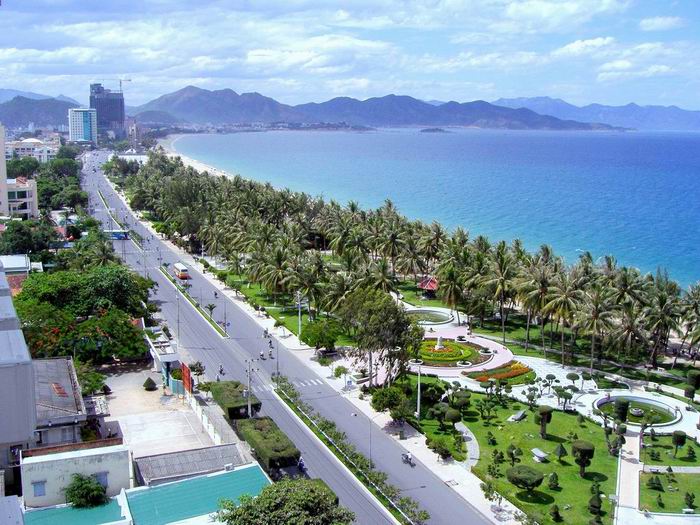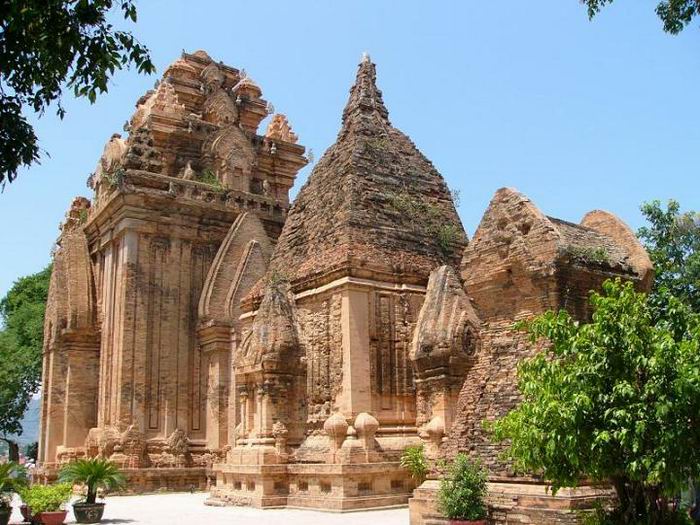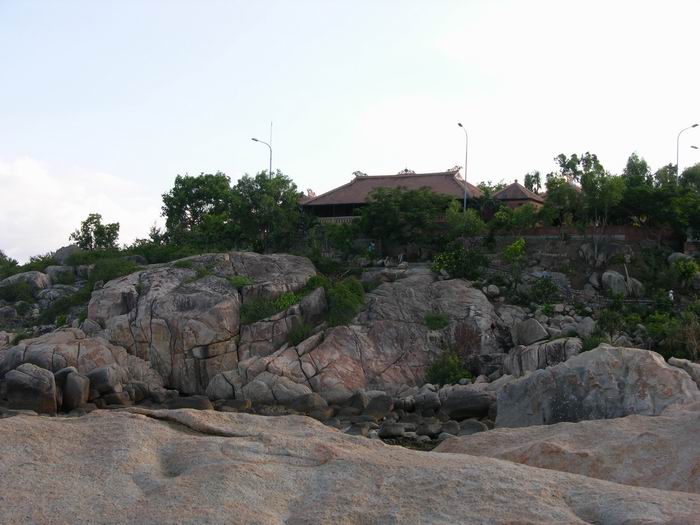Nha Trang has a split personality. One takes the
form of a smaller Danang - a bustling Vietnamese city humming with
commerce but blessed with access to a beautiful beach. The other is a
Western resort town encompassing several blocks of hotels, tourist
shops, bars and international restaurants. Entering this sheltered
enclave you could be anywhere in the world, if it weren't for the
constant hassling from xe om drivers, many of whom seem to moonlight as
pimps and dealers. The city is indisputably beautiful, bordered by
mountains, with the beach tracing an impressive long swoop along a bay
dotted with islands. Topiary and modern sculpture dot the immaculately
manicured foreshore. The only blight on the horizon is the
Hollywood-style sign for the Vinpearl complex - an ugly scar dominating
nearby Hon Tre Island. Nha Trang offers plenty to keep tourists occupied
- from island-hopping boat trips and
scuba diving, to
mudbaths and
historic sites. But the main attraction for most visitors is lounging
around on deckchairs at a beach front bar and drinking cocktails in
comfort.

NHA TRANG BEACH
The clear turquoise waters of Nha Trang's 6km beach are best enjoyed
during the dry season -from June to early October. During heavy rains,
run off from the rivers at each end of the beach flows into the bay,
gradually turning it a murky brown. Most of the year, however, the water
is as it appears in the tourist brochures. Even in the wettest months,
rain usually falls only at night or in the morning. The best beach
weather is generally before 1pm; the afternoon sea breezes can make
things unpleasant until the wind dies back down around 8pm. Beach chairs
are available for rent where you can sit and enjoy the drinks, light
food or massages that the beach vendors have on offer. About the only
time you'll need to move is to use the toilet or when the tide comes up.
The two most popular lounging spots are the Sailing Club and Louisiane
Brewhouse .
PO NAGAR CHAM TOWERS

The
Cham towers of Po Nagar were built between the 7th
and 12th centuries, although the site was used for worship as early as
the 2nd century AD. To this day Cham, ethnic Chinese and Vietnamese
Buddhists come to Po Nagar to pray and make offerings, according to
their respective traditions. This site has a continuing religious
significance, so be sure to remove your shoes before entering. The
towers serve as the Holy See, honouring Yang Ino Po Nagar, the goddess
of the Dua (Liu) clan, which ruled over the southern part of the Chain
kingdom covering Kauthara and Pan Duranga (present day Khanh IIoa and
Thuan Hai provinces). The original wooden structure was razed to the
ground by attacking Javanese in AD 774 but was replaced by a
stone-and-brick temple (the first of its kind) in 784. There arc
inscribed stone slabs scat-tered throughout the complex, most of which
relate to history or religion, and provide insight into the spiritual
life and social structure of the Chain. Originally the complex covered
an area of 500 sq metres and there were seven or eight towers, four of
which remain. All of the temples face cast, as did the original entrance
to the complex, which is to the right as you ascend the hillock. In
centuries past, a person coming to pray passed through the pillared
meditation hall, 10 pillars of which can still be seen, before
proceeding up the steep staircase to the towers. The 28m-high
North Tower (Thap Chinh), with its terraced
pyramidal roof, vaulted interior masonry and vestibule, is a superb
example of Cham architecture. One of the tallest Cham towers, it was
built in AD 817 after the original temples here were sacked and burned.
The raiders also carried off a linga made of precious metal. In AD 918
King Indravarman III placed a gold mukha-linga (a carved phallus with a
human face painted on it) in the North Tower,
but it too was taken, this time by the Khmers. This pattern of statues
being destroyed or stolen and then replaced continued until 965, when
King Jaya Indravarman I replaced the gold mukha-linga with the stone
figure, Uma (shakti, or a feminine manifestation of Shiva), which
remains to this day. Above the entrance to the North Tower, two
musicians flank a dancing four-armed Shiva, one of whose feet is on the
head of the bull Nandin. The sandstone doorposts are covered with
inscriptions, as are parts of the walls of the vestibule. A gong and a
drum stand under the pyramid-shaped ceiling of the antechamber. In the
28m-high pyramidal main chamber, there is a black stone statue of the
goddess Uma with 10 arms, two of which are hidden under her vest; she is
seated and leaning back against some sort of monstrous animal. The
Central Tower (Thap Nam) was built partly
of recycled bricks in the 12th century on the site of a structure dating
from the 7th century. It is less finely constructed than the other
towers and has little ornamentation; the pyramidal roof lacks terracing
or pilasters, although the interior altars were once covered with
silver. There is a linga inside the main chamber. Note the inscription
on the left-hand wall of the vestibule. The South
Tower (Mieu Dong Nam). at one time dedicated to Sandhaka (Shiva),
still shelters a linga, while the richly ornamented
Northwest Tower (Thap Tay Bac) was
originally dedicated to Ganesh. To the rear of the complex is a small
museum with a few mediocre examples of Cham
stonework; the explanatory signs are in Vietnamese only. The towers of
Po Nagar stand on a granite knoll, 2km north of central Nha Trang on the
banks of the Cat River. To get here from central Nha Trang, take Đ Quang
Trung (which becomes D 2 Thang4) north across the Ha Ra and Xom Bong
Bridges. Po Nagar can also be reached via the new Tran Phu Bridge along
the beachfront road.
LONG SON PAGODA
This striking pagoda was founded in the late 19th century and has been rebuilt
several times over the years. The entrance and roofs are decorated with
mosaic dragons constructed of glass and bits of ceramic tile. The main
sanctuary is a hall adorned with modern interpretations of traditional
motifs. Note the ferocious nose hairs on the colourful dragons wrapped
around the pillars on either side of the main altar. At the top of the
hill, behind the pagoda, is a huge white Buddha
(Kirn Than Phat To) seated on a lotus blossom and visible from all over
the city. Around the statue's base are fire-ringed relief busts of Thich
Quang Due and six other Buddhist monks who died in self-immolations in
1963. The platform around the 14m-high figure has great views of Nha
Trang and nearby rural areas. Ar you approach the pagoda from the
street, the 152 stone steps up the hill to the Buddha begin to the right
of the structure. You should take some time to explore off to the left,
where there's an entrance to another hall of the pagoda. Genuinely
desperate-seeming beggars congregate within the complex, as do a number
of scam-artists. The pagoda is located about 400m west of the train
station, just off Đ 23 Thang10.
NATIONAL OCEANOGRAPHIC MUSEUM
Housed in a grand French-colonial building in the port district of Cau
Da at the fai south end of Nha Trang is the
National Oceano-graphic Museum ( 1 Cau Da; adult/child
15,000/7000d; (6am-6pm). Attached to the Occanographic Institute founded
in 1923, signs direct you around the tanks of colourful live marine life
and the 60,000 jars of pickled specimens that make up the collection.
There are also stuffed birds and sea mammals and displays of local boats
and fishing artefacts. Most of the signs have English translations, so a
guide is unnecessary
ALEXANDRE YERSIN MUSEUM
Dr Alexandre Yersin (1863-1943) founded Nha Trang's
Pasteur Institute in 1895. He was probably
the Frenchman most loved by the Vietnamese. Born in Switzerland, he came
to Vietnam in 1889 after working under Louis Pasteur in Paris. He
learned to speak Vietnamese fluently, and spent the next few years
travelling throughout the central highlands and recording his
observations. During this period he came upon the site of what is now
Dalat and recommended to the government that a hill station be
established there. Yersin also introduced rubber and quinine-producing
trees to Vietnam. In 1894, while in Hong Kong, he discovered the
rat-borne microbe that causes bubonic plague. At his request. Dr Yersin
was buried near Nha Trang. Today, the Pasteur Institute in Nha Trang
coordinates vaccination and hygiene programmes for the country's
southern coastal region. The institute produces vaccines and carries out
medical research and testing to European standards. Physicians at the
clinic here offer medical advice to around 70 patients a day. Vietnam's
two other Pasteur Institutes are in HCMC and Dalat. Yersin's library and
office are now an interesting museum
(Tell:822 355; 10 Đ Tran Phu; admission 26,000(8-11am & 2-4.30pm
Mon-Fri, 8-11am Sat). Items on display include laboratory equipment
(such as his astronomical instruments), books from his library, a
fascinating 3-D photo viewer and some of the thousand or so letters
written to his mother! The model boat was given to him by local
fishermen with whom he spent a great deal of his time. Tours of the
museum arc guided in French, English and Vietnamese, and a short film on
Yersin's life is also shown,
HON CHONG PROMONTORY
The narrow granite promontory of
Hon Chong offers views of the
mountainous coastline north of Nha Trang and the nearby islands. The
beach here has a more local flavour than Nha Trang Beach, but the
accompanying refuse makes it a less attractive option for swimming or
sunbathing. There's a gargantuan handprint on the massive boulder
balanced at the tip of the promontory. According to legend, a drunken
giant male fairy made it when he fell while spying a female fairy
bathing nude at Bai Tien (Fairy Beach), the point of land closest to Hon
Rua. They fell in love but the gods intervened, sending the male fairy
away. The lovesick female fairy waited patiently for him to return, but
after a very long time she lay down in sorrow and turned into
Nui Co Tien (Fairy Mountain). Looking to
the northeast from Hon Chong Promontory, the peak on the right is
supposed to be her face, gazing up towards the sky; the middle peak is
her breasts; and the summit on the left (the highest) forms her crossed
legs. About 300m south of Hon Chong
(towards Nha Trang) and a few dozen metres from the beach is tiny
Hon Do (Red Island), which has a Buddhist
temple on top. To the northeast is Hon Rua
(Tortoise Island), which really does resemble a tortoise. The two
islands of Hon Yen are off in the distance
to the east.
AROUND NHA TRANG
HON TRE (BAMBOO ISLAND)
The beauty of Nha Trang's largest and closest offshore island is now
marred on the city side by a huge Hollywood-style sign advertising
Vinpearl. Complex International - a new compound of restaurants,
nightclubs, shops, kids' rides, hotels and an amphitheatre. The wealthy
Ukrainian-Vietnamese owners have now started work on a cable car
stretching 3 kilometres from Vinpearl to the mainland.
HON MIEU
All the tourist literature touts Hon Mieu (also called Tri Nguyen
Island) as the site of an outdoor aquarium (Ho Ca Tri Nguyen). In fact,
the aquarium is an important fish-breeding farm, where over 40 species
offish, crustacean and other marine creatures are raised in three
separate compartments. There is also a cafe built on stills over the
water. Ask around for canoe rentals. The main village on Hon Mieu is Tri
Nguyen. Bai Soai is a gravel beach on the far side of Hon Mieu from Cau
Da. There are a few rustic bungalows (US$6)
on the island. Most people will take some sort of boat tour booked
through a hotel, cafe or Khanh Hoa Tourist. Impoverished and
less-hurried travellers might catch one of the regular ferries that go
to Tri Nguyen village from Cau Da dock.
HON MUN (EBONY ISLAND)
Hon Mun is situated just southeast of Bamboo Island and is well known
for its snorkelling;
HON MOT
Sandwiched neatly between Ebony Island am Hon Tam is tiny Hon Mot; it's
another great place for snorkelling.
HON YEN (BIRD'S-NEST ISLAND)

Also known as
Salangane Island, this is the name applied to (who
lump-shaped island visible from Nha Trang Beach. These and other islands
off Khanh Hoa province are the source of Vietnam's finest swiftlet (salangane
nests. There Is a small, seclude beach here. The 17 km
trip out to the island takes three to four hours by small boat from Nha
Trang.
Suoi Tien (Fairy Spring)
The enchanting little spring seems to pop out of nowhere. Like a small
oasis, the Fairy Spring is decorated with its own natural garden of
tropical vegetation and smooth boulders. You'll need to rent a motorbike
or car to reach the spring- Drive south on Hwy 1 A for 27km to Suoi Cat,
turning right (west) at the blue and white 'Huong Lo 39' sign. After 5km
you'll see a sign directing you to the spring.
Cam Ranh Harbour
The gorgeous natural harbour of Cam Ranh Bay
is 35km south of Nha Trang and 56km north of Phan Rang. With the opening
of the excellent new airport road, beautiful Bai
Dai (Long Beach), forming the northern head of the harbour, has
become much more accessible. Largely unspoilt, the government has been
encouraging development - although at the time of research the one major
completed resort had long been languishing unopened in search of a
buyer. Driving the beach road, reminders of the American War come in the
form of abandoned tanks peering out of the sand. The military still
controls access to much of this area but are starting to work with
tourist operators. Nha Trang's Mana Mana Beach Club has negotiated
access to some of the best surf breaks in Vietnam. To get here you can
take the airport shuttle bus. although you'll need to time your visit
around flight times. A one-way journey in a taxi will cost about
150,000d, but you'll be able to negotiate something considerably
cheaper, including waiting time, with a motorcycle driver.
Source: lonely planet